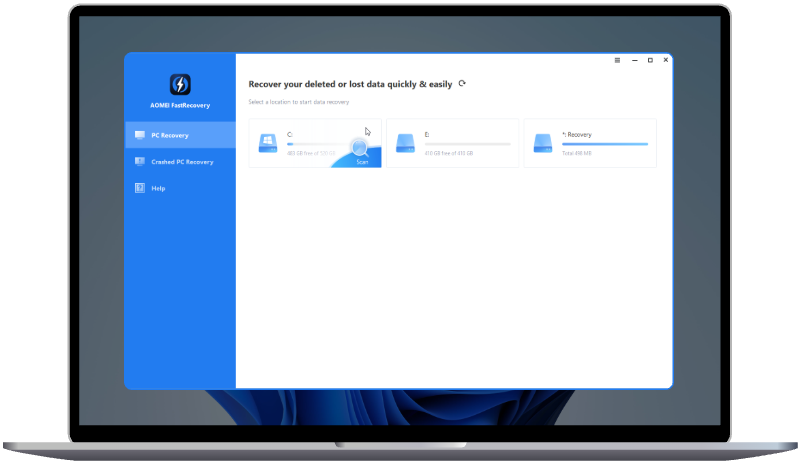[3 Fixes] Unable to Extend C Drive Due to Recovery Partition in Windows 11/10
When your C drive runs out of space, the logical solution is to extend it. However, if a recovery partition is blocking the unallocated space, it can make this process frustrating. This guide will walk you through practical steps to fix unable to extend C drive due to recovery partition.
How to expand the Windows partition when the Recovery one is in the way?
"My partitions on my primary disk look like this:
I would like to expand C: with the Unallocated space but the 946 MB Recovery partition is in the way. Is there a way to swap the Recovery partition with the Unallocated space (= move it to the end of the disk), to have contiguous WINDOWS and Unallocated space?
What would be the consequences of removing that 946 MB Recovery partition? There are numerous articles mentioning that it exists and how to remove it (with diskpart), but not what it actually stores and whether it is primordial to have it (as opposed to having a Windows 10 media disk one can boot from and go into repair mode)"
Unable to extend C drive due to recovery partition
Expanding the C drive on your Windows system is often necessary to free up space or optimize system performance. However, many users complain that they are unable to extend C drive due to recovery partition. This small but significant partition can block your ability to extend the C drive.
A recovery partition is a reserved section of your hard drive created by your operating system or PC manufacturer. It typically contains tools for troubleshooting, repairing, or resetting your system to factory settings. These partitions are often hidden, but they play a crucial role in ensuring system stability and recovery options.
The issue arises because of how disk partitions are organized. When you attempt to extend the C drive using the Windows Disk Management tool, the extension process requires unallocated space immediately adjacent to the C drive. If a recovery partition is located between the C drive and unallocated space, the extension option becomes unavailable.
How to fix unable to extend C drive due to recovery partition
A recovery partition on Windows 10 may prevent volume extension. Wondering how to fix this? Here are three effective solutions to resolve the issue.
Method 1. Delete the recovery partition to make unallocated space adjacent
If a recovery partition is preventing you from extending a volume, you can safely delete the recovery partition without impacting the normal functioning of Windows. However, since this partition is used for factory resets, it’s wise to back it up before proceeding if you need it for future system recovery.
While Disk Management cannot remove a recovery partition, you can use the built-in DiskPart tool. Here’s how:
Note: Back up important data or create a recovery drive before deleting this partition.
Step 1. Open the search box on your desktop and type “cmd”.
Step 2. Right-click on "Command Prompt" and select "Run as administrator".
Step 3. In the Command Prompt window, type diskpart and press ENTER to launch the DiskPart utility.
Step 4. Enter the following commands one by one, pressing ENTER after each:
list disk
select disk 1 (Replace 1 with the disk number containing the recovery partition.)
list partition
select partition 1 (Replace 1 with the partition number of the recovery partition.)
delete partition override
This process will delete the recovery partition and free up space for volume extension.
Method 2. Move unallocated space to the right behind C drive
If you prefer not to delete the recovery partition or aren’t comfortable using command-line tools, there’s an alternative solution: AOMEI Partition Assistant. This versatile tool allows you to move unallocated space to sit right behind your C drive and expand it without losing data. This intuitive tool ensures efficient partition management for both beginners and advanced users.
Step 1. Open AOMEI Partition Assistant. If the recovery partition is between the partition you want to extend and the unallocated space, right-click on the recovery partition and select Resize/Move Partition.
Step 2. In the Move Partition screen, click and hold to drag the recovery partition towards the right hand side and then click OK.
Step 3. Now you can preview the partition layout after moving recovery partition in Windows 10. If there is no problem, click Apply to save the changes.
If you need to add unallocated space to the C: drive, right-click it and choose Resize Partition to successfully extend the system disk. In addition, you can utilize AOMEI Partition Assistant’s "Merge Partition" feature to combine available unallocated space into another partition. So that you can easily solve the “unable to extend C drive in Windows 10 due to recovery partition” problem.
Method 3. 1-Click adjust C drive via a third-party tool(data safe)
Beyond these features, AOMEI Partition Assistant also offers functionalities such as partition formatting, wiping, and cloning, making it an all-in-one solution for managing your disk partitions efficiently. Among all these features, one called “1-click Adjust Space” can fully meet your needs when you are unable to extend C drive due to recovery partition Windows 11 or 10. It allows you to adjust a partition space by simply dragging the dots next to the partitions' head and tail, which means you can directly enlarge the size of C drive without moving or deleting the recovery partition.
Step 1. Install and launch AOMEI Partition Assistant. Right-click a partition (here is D: partition) you want to adjust space and select "1-Click Adjust Space".
Step 2. If you want to use the space on F: to expand D:, you can simply drag the dot near the partition F: head backward to shrink the partition F: and enlarge the partition D: at the same time. Then click "OK".
Tips: You can simultaneously drag the dot near the partition C: tail forward to shrink the partition C: so the D: will also be enlarged with the space of C: at the same time. In this case, you can adjust all partition space (C:, D:, and F:) on the disk.
Step 3. You can preview the operation by viewing the "Pending Operations". To commit the "Pending Operations", please click "Apply" and "Proceed".
Step 4. The process will start and you can check the progress. It might take time to finish the operation.
Step 5. Wait for the operation to be finished. After it is completed successfully, you will find D: is enlarged and both D: and F: are adjusted.
Conclusion
If a recovery partition is preventing you from extending a volume on Windows 10, there are several effective solutions available. You can delete the recovery partition using Disk Management, though it may have limitations. For a more advanced option, consider AOMEI Partition Assistant, which allows you to move the recovery partition or adjust the C drive directly.
AOMEI Partition Assistant provides more functions, such as resizing encrypted partitions. If you're managing a server, the Server Edition is specifically designed to meet your needs.

